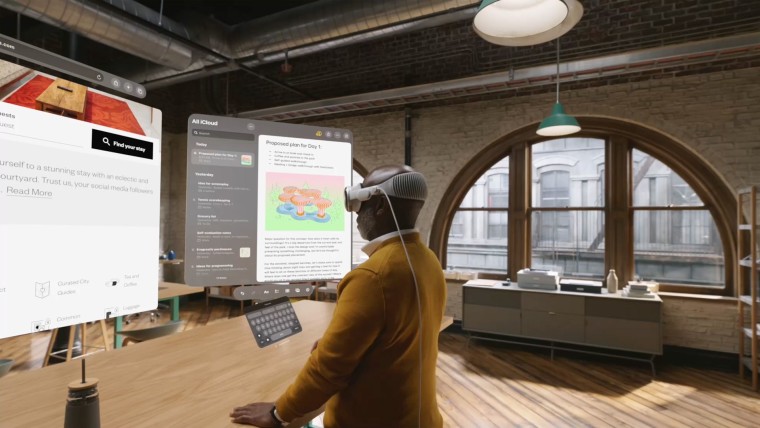
While I was watching the WWDC keynote live stream on Monday, waiting for what would eventually be revealed as the Apple Vision Pro to be announced, I wondered if I would get that "Wow!" factor like I got when the original iPhone was announced. The late Apple co-founder Steve Jobs promoted the first iPhone as a portable computer, a mobile phone, and a media device smashed into one product. The result was something that everyone wanted to get their hands on.
When the Apple Vision Pro presentation was finally over, I will admit I was wowed by quite a few things. I loved the high pixel-density displays. I love the fact that I would not need to hold onto any physical controllers to use it. I loved some of the demos of how the apps would work, especially when watching video content.
But in the end, I didn't get that overall "Wow!" factor with the Vision Pro as I did with the original iPhone. Instead, my thought was, "Why?" As in, "Why is Apple revealing this AR headset at this moment in time?"
Don't get me wrong. The Vision Pro does have a lot of impressive features that I want to try out eventually. There have been a few hands-on reports from WWDC from people like Marques Brownlee and YouTube channels like Tested or CNET. Interestingly, Apple didn't allow the press to take any pictures or videos of people actually wearing the headset during WWDC. In fact, I thought it was curious that none of Apple's executives, including CEO Tim Cook, were seen wearing the Vision Pro during the recorded presentation. Hmmm..

Anyway, based on those hands-on reports, it sounds like the Apple Vision Pro is going to be great for viewing content like movies and TV shows with its immersive displays. It will also likely be great for video conferencing and even just chatting casually with others.
I'm a bit more skeptical about how the demos of AR-based apps for businesses will work in the headset as they did in the controlled presentation. Also, I'm not sure whether those Microsoft productivity apps would actually work as well in the real world compared to just viewing them on a monitor and using a mouse and keyboard. However, I'm willing to be proven wrong if the Vision Pro's gesture and eye tracking sensors will indeed be fluid to use with little to no latency.
Having said all of that, it's clear that this is a first-generation product at Apple. In fact, I might go even further to say it's a zero-generation product. The Apple Vision Pro headset is clearly not meant to be something bought by the normal consumer right now. Apple's announced price of $3,499, and a launch date of early 2024 (missing the crucial holiday buying season) means the company is targeting this device mostly to app developers.
That sounds a lot like Microsoft's business plan for its HoloLens devices. Microsoft tried to promote those AR headsets as gaming devices, among other things, but in the end, the high price and low unit production meant that the general public couldn't just walk into a store and get one. The Apple Vision Pro launch is meant to make developers get the device so that when the company gets its true first-gen AR headset, it will have lots of native apps ready to go for a product made for the ordinary consumer.
That's the device that I'm waiting to buy. So, I will ask again, " "Why is Apple revealing this AR headset at this moment in time?" It's great that they have this new immersive platform for viewing content and possibly for getting some work done. However, it could have just revealed on Monday that the Apple Vision Pro was being launched as a developer device exclusively, and not push it as something that an ordinary person would want to get right now.

There's also the fact that some of the hands-on impressions of the Vision Pro complained about the very short two hour battery life when it's not connected to a power outlet. That's a serious issue. I've also read reports that the headset itself can become uncomfortable to wear after about 15 to 20 minutes. Considering Apple showed off people watching movies in the Vision Pro demo, and that films can run for two hours or more, this sort of thing needs to be addressed.
Apple may claim that the uncomfortable fit that some media people felt while wearing the headset was due to the fact that the demo units did not have custom fittings like the regular version will have. However, I remain skeptical that even with that kind of custom fit, it may be awkward to wear the Vision Pro for more than an hour or so at a time.
Finally, even with all that great hardware and the impressive demos, the simple fact is that I don't think people are ready to wear something that looks like really heavy ski goggles over their eyes, no matter how comfortable it may be. I could be wrong about that, but the truth is one of the biggest issues with VR headsets for decades is people just look silly wearing them, and the Vision Pro does absolutely nothing to solve that problem. That may be why Apple's executives were not wearing them at the WWDC presentation, and why it didn't allow the media to be seen wearing them as well.
In the end, the Apple Vision Pro is an excellent first glimpse at what the company may bring to the AR/VR industry . . . someday. Right now, it's a device that's too expensive, too silly to wear, and with lots of questions about how it will work outside Apple's HQ. Apple should have just waited until they could turn my "Why?" into "Wow!".

















70 Comments - Add comment